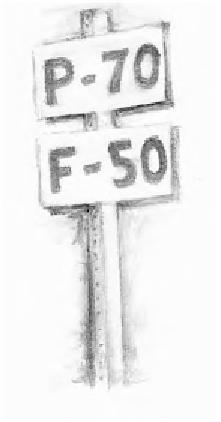Travel Reference
In-Depth Information
Flags
These come in four colors: red, yellow, green, and blue. Orig-
inally, flags were used as warning signals. Three of the colors
mean exactly what you would think: red for “stop,” yellow for
“slow,” and green for “resume normal speed.” Their purpose is
to alert the engineer to something ahead
that's on or near the track. Usually a
work crew is involved, perhaps clear-
ing a rockslide from the track or simply
doing normal track maintenance. What-
ever the reason, these flags are a visual
warning to the engineer. Blue flags are
placed at the front and rear of a stand-
ing car or several cars or an entire train,
and they alert all concerned that people
are working around or under the cars.
Although still called “flags” by rail-
road people, these signs are usually
colored squares of metal attached to a
little metal pole. (At least they still
look
like flags.) It's easy to miss these flags.
They're pretty small, perhaps eight
square inches. Usually you'll see them
stuck into the ballast rock alongside the
track just a foot or so from the rail. At
night, electric lanterns in the appropri-
ate color are used.
There are a number of
variations for railroad speed
limit signs, but this message
is clear: passenger trains
may go 70 mph, but freights
cannot exceed 50 mph.
Speed Limit Signs
You'll also notice a lot of these. As the name implies, they tell
the engineer how fast she's allowed to travel. Most of the time
there are two numbers posted. The top number is the speed limit











Search WWH ::

Custom Search